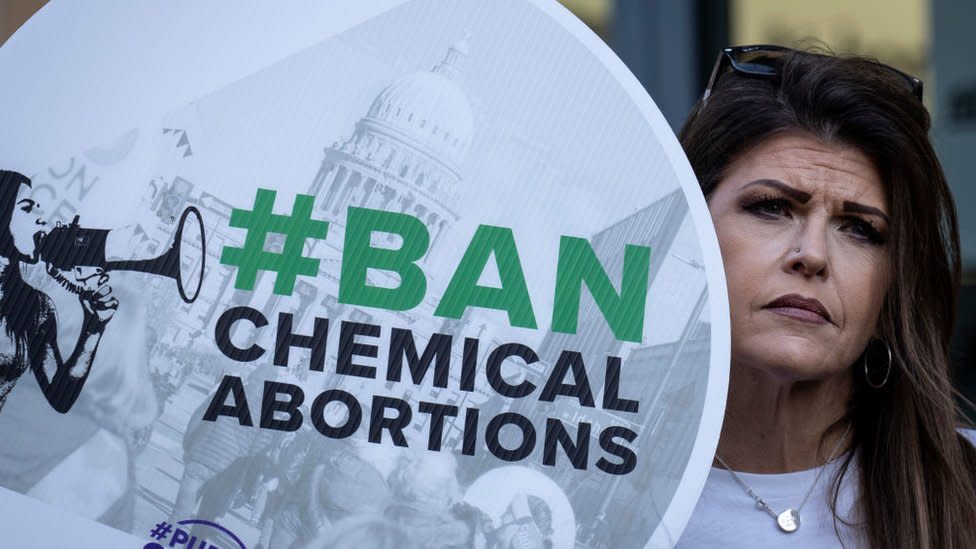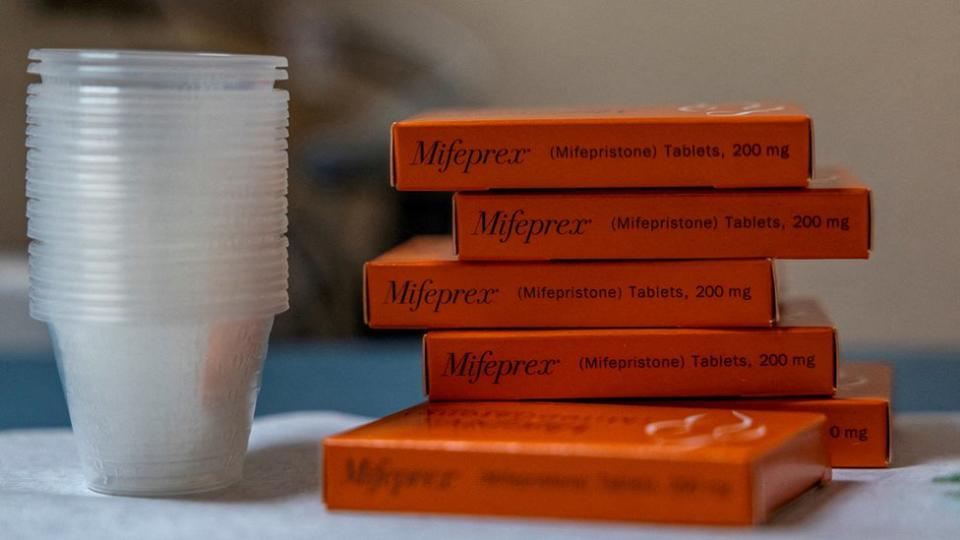What is the abortion pill mifepristone and is it safe?

Abortion pills are now the most common method of ending a pregnancy in the US, accounting for nearly two-thirds of all abortions in the country.
They have also become the new frontier in the US battle over abortion access.
Much of the fight is focused on mifepristone, one half of the two-pill regimen that makes up the safest and most effective mode of medication abortion.
In June, the Supreme Court blocked an effort to restrict access to the drug.
But the court left the door open to future challenges, meaning it may be in legal limbo again.
Here is a look at mifepristone, what it does and where it is used.
What is mifepristone?
Mifepristone is the first of the two-pill regimen recommended by the Food and Drug Administration (FDA) to end a pregnancy.
It works by blocking a hormone called progesterone, which is necessary for a pregnancy to continue. The second drug, misoprostol, empties the uterus. US studies say the two-step medication regime is effective 95% of the time.
The US first approved mifepristone for the medical termination of pregnancy through seven weeks gestation in September 2000. In 2016, its approved use was extended to 10 weeks of pregnancy.

Misoprostol has been available by prescription for decades as a treatment for stomach ulcers and to manage postpartum haemorrhaging. Its non-pregnancy related uses are likely why it has not attracted the same controversy as mifepristone.
Meanwhile, mifepristone is also used to treat women who have suffered miscarriages and Cushing syndrome, a hormone-related condition.
According to the FDA, over 3.7 million women used mifepristone in the US between 2000 and 2018.
Is mifepristone safe?
For over 20 years of use, the FDA, the American College of Obstetrics and Gynaecologists (ACOG) and other mainstream medical organisations have maintained that both mifepristone and misoprostol are safe for use.
US studies say the two-step medication regime is about 95% effective in ending pregnancy and requires further medical follow-up less than 1% of the time.
Increasingly, anti-abortion campaigners have said that abortion medication, which they call "chemical abortion", is risky and ineffective. However, their claims are not supported by leading medical organisations, such as the World Health Organization and the American Medical Association.
According to the FDA, there are five deaths per million users of mifepristone. In comparison, a 2001 study in the Journal of the American Medical Association found there were about 20 deaths per million users of penicillin, due to an allergic reaction to the commonly prescribed antibiotic.
Who challenged access?
An umbrella group of anti-abortion doctors and activists known as the Alliance for Hippocratic Medicine filed a lawsuit in November 2022, claiming mifepristone was unsafe and that the FDA erred by fast-tracking its approval process, and that it did not adequately consider the safety risks.
The FDA said the process was not rushed, and that it took four years and reviewed many studies with tens of thousands of participants before approving the abortion pill. The FDA did use a part of US drug regulations that was designed to help "fast-track" approval processes, but it said it only used that provision to add further restrictions for safety reasons, such as requiring women to be assessed for the risk of ectopic pregnancies.
The case eventually made its way to the Supreme Court, which heard arguments in March 2024.
Three months later, in June, the justices ruled unanimously that the plaintiffs did not have a legal right to sue - known as standing - because they did not prove mifepristone's availability had caused them harm.
"A plaintiff's desire to make a drug less available for others does not establish standing to sue," wrote Justice Brett Kavanaugh for the court.
Where is it available?
Mifepristone and misoprostol are widely available in states where abortion is legal.
The drugs' availability was expanded in April 2021, when the FDA said it would lift the in-person dispensing requirement for mifepristone for the duration of the Covid-19 pandemic. In December of last year, the FDA permanently lifted that requirement, meaning the medication was allowed to be sent by mail.
The decision was applauded by pro-choice advocates. And to some, abortion pills delivered by mail were seen as a workaround for the abortion bans that swept the country after the reversal of Roe v Wade last June.
Access was further expanded in 2022 by another FDA change, which allowed retail pharmacies to dispense out the drug. Previously, only health-care providers were permitted to give out the drug.

What questions do you have on the issues in this story? Get in touch.
Email haveyoursay@bbc.co.uk
WhatsApp: +44 7756 165803
Tweet: @BBC_HaveYourSay
Please read our terms & conditions and privacy policy



